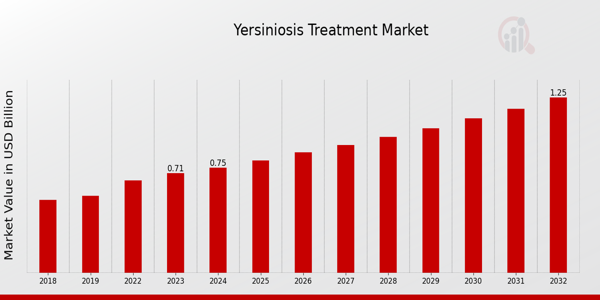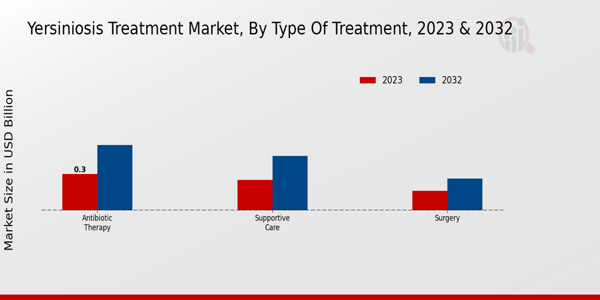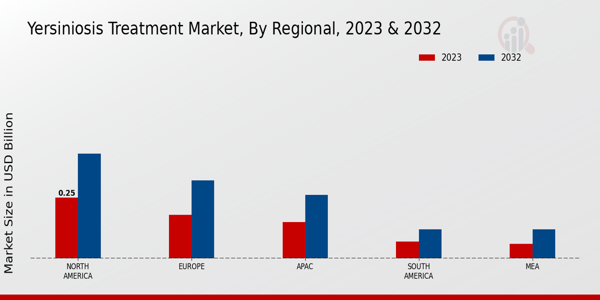Yersiniosis Treatment Market Overview
As per MRFR analysis, the Yersiniosis Treatment Market Size was estimated at 0.80 (USD Billion) in 2024. The Yersiniosis Treatment Market Industry is expected to grow from 0.85 (USD Billion) in 2025 to 1.50 (USD Billion) till 2034, at a CAGR (growth rate) is expected to be around 6.52% during the forecast period (2025 - 2034).
Key Yersiniosis Treatment Market Trends Highlighted
The Yersiniosis Treatment Market is experiencing significant growth, driven by an increase in the prevalence of Yersiniosis cases globally. Rising awareness about foodborne illnesses and heightened focus on public health regulation have propelled market demand. Additionally, advancements in diagnostic technologies are enabling quicker identification of yersiniosis and facilitating timely treatment interventions. The development of antibiotics and supportive care therapies further complements treatment options available to healthcare providers. Opportunities in the market are plentiful as research and development efforts continue to innovate treatment solutions.The emergence of novel therapies and the exploration of alternative medications are gaining traction. Additionally, expanding healthcare infrastructure in developing regions presents a unique opportunity to enhance treatment access, which can potentially improve patient outcomes. Increased collaboration between pharmaceutical companies and research institutions aims to develop more effective treatment protocols, addressing the existing gaps in management strategies. In recent times, the market haswitnessed a trend towards personalized medicine, wherein treatments are tailored to individual patient profiles, improving efficacy and reducing adverse effects.The integration of technology in treatment, such as telemedicine and mobile health applications, is becoming more prevalent, enabling remote monitoring and management of yersiniosis. There is also a shift towards preventative measures, with an emphasis on vaccination research and public awareness campaigns aimed at reducing the incidence of infections. All these factors contribute to a dynamic and evolving landscape in the Yersiniosis Treatment Market.

Source: Primary Research, Secondary Research, MRFR Database and Analyst Review
Yersiniosis Treatment Market Drivers
Increasing Incidence of Yersiniosis Infections
The Yersiniosis Treatment Market Industry is witnessing a rise in growth with the increasing cases of yersiniosis infections. This is a gastrointestinal disease caused by the Yersinia enterocolitica bacterium, and if not treated in time, severe complications can arise. Due to the globalization of food and its practices, it can be observed that yersiniosis cases have been on the rise. This rising trend indicates the growing need for available treatment.
With more education regarding yersiniosis and its routes of transmission among healthcare practitioners and the general population, there is a growing need for treatment solutions. The shift in travel and immigration patterns in the modern age also presents an option to spread these infections, widening the market further. An additional point is the increasing healthcare infrastructure in developing countries, which has improved the availability of yersiniosis diagnosis and treatment.
In light of the above, one can safely conclude that the need for effective treatment is not confined only to developed countries. It is also emerging in developing regions. Such growing demand will lead to additional research and development investments from pharmaceutical and biotechnology firms willing to deliver advanced approaches specifically aimed at yersiniosis management. With the increasing concentration on patients, the yersiniosis treatments market will benefit from all existing tendencies and these have definitely been beneficial for such market in the past.
Advancements in Treatment Modalities
Advancements in treatment modalities represent another significant driver of the Yersiniosis Treatment Market Industry. Recent technological innovations in pharmaceuticals have led to the development of more effective antibiotics and supportive therapies designed specifically to combat yersiniosis. These new treatments not only improve patient outcomes but also reduce the length of hospital stays and overall healthcare costs. The ongoing research into new drug formulations and treatment options is an essential aspect of the industry, as it caters to the evolving needs of healthcare providers and patients.The incorporation of innovative treatment approaches makes it more feasible for clinicians to manage yersiniosis effectively, further contributing to market growth.
Growing Awareness and Education
The growing awareness and education regarding yersiniosis are crucial factors driving the Yersiniosis Treatment Market Industry. Educational initiatives from health organizations and governments aim to inform healthcare professionals and the public about the symptoms, transmission, and treatment options for yersiniosis. As more individuals understand the risks associated with yersiniosis and the importance of early diagnosis and treatment, there will be an increase in demand for medical interventions.Improved knowledge and education also help reduce the stigma associated with this infection, allowing affected individuals to seek treatment sooner. Consequently, this heightened awareness plays a vital role in driving market growth.
Yersiniosis Treatment Market Segment Insights:
Yersiniosis Treatment Market Type of Treatment Insights
The Yersiniosis Treatment Market is poised for growth, driven by the increasing prevalence of Yersiniosis and the need for effective treatment options. In 2023, the market dshowcased a valuation of 0.71 USD Billion, with the Type of Treatment segment being a crucial area of focus for stakeholders. This segment encompasses several approaches, including Antibiotic Therapy, Supportive Care, and Surgery, each playing a significant role in the management of the disease. The majority holding in this segment is Antibiotic Therapy, valued at 0.3 USD Billion in 2023 and projected to grow to 0.54 USD Billion by 2032, reflecting its vital importance in combating bacterial infections effectively.This treatment is often a primary choice due to its direct action against pathogenic bacteria responsible for Yersiniosis, making it a dominant player within the market. Supportive Care, valued at 0.25 USD Billion in 2023 and expected to rise to 0.45 USD Billion by 2032, serves as a complementary approach, focusing on alleviating symptoms and enhancing patient comfort during recovery, showcasing its significant role in the comprehensive management of the disease. Despite being the smallest category, Surgery still holds importance in severe cases with complications, with a valuation of 0.16 USD Billion in 2023, anticipated to reach 0.26 USD Billion by 2032.As an essential aspect of the treatment continuum, this method is reserved for select patients, underscoring the necessity for advanced intervention when medical therapies are insufficient. Overall, the Yersiniosis Treatment Market is reflective of an evolving landscape in which these treatment types adapt to new challenges, driven by market growth, technological advancements, and expanding healthcare access, while also addressing challenges such as antibiotic resistance and varying healthcare infrastructures across regions.

Source: Primary Research, Secondary Research, MRFR Database and Analyst Review
Yersiniosis Treatment Market Route of Administration Insights
The Yersiniosis Treatment Market, specifically focusing on the Route of Administration, is gaining attention within the healthcare sector. In 2023, the market was valued at approximately 0.71 billion USD. The market encompasses various methods of drug delivery, including Oral, Intravenous, and Topical administration. Oral administration often dominates due to its ease of use and patient compliance, making it a preferred choice for many treatments. Intravenous administration, while less commonly utilized, is crucial in acute cases where rapid drug action is necessary.Topical administration also plays an essential role, particularly for localized treatments. As the market continues to evolve, trends such as increasing patient awareness and advancements in drug formulations contribute to the growth of the Yersiniosis Treatment Market. Moreover, challenges such as regulatory hurdles and varying patient preferences may impact market dynamics. Overall, the Yersiniosis Treatment Market segmentation by Route of Administration is critical for understanding the various strategies healthcare providers and pharmaceutical companies utilize to combat this infectious disease effectively.
Yersiniosis Treatment Market Patient Age Group Insights
The Yersiniosis Treatment Market, valued at 0.71 USD Billion in 2023, shows significant segmentation based on the Patient Age Group, which plays a crucial role in shaping the market dynamics. This segment comprises three main categories: Pediatric, Adult, and Geriatric. The Pediatric age group is noteworthy as it tends to reflect higher disease susceptibility, necessitating targeted treatment approaches. Adults represent a substantial portion of the market, often experiencing complications that require advanced therapeutic solutions, contributing to the overall market growth.Meanwhile, the Geriatric population is increasingly emphasized due to their weakened immune systems, making effective Yersiniosis treatment essential. Overall, the opportunities in tailoring treatments for these specific age demographics create a landscape for innovation and targeted healthcare strategies within the Yersiniosis Treatment Market. Current trends reveal a growing focus on personalization in treatment modalities, driven by advances in medical technology and an increasing emphasis on patient-centric healthcare solutionsfactors that are expected to propel the market forward.
Yersiniosis Treatment Market Indication Insights
The Yersiniosis Treatment Market revenue for 2023 was valued at 0.71 billion USD, reflecting the rising awareness and advancements in healthcare related to this infectious disease. As the market evolves, it is segmented into distinct categories, including Intestinal Yersiniosis, Extraintestinal Yersiniosis, and Chronic Yersiniosis. Among these, Intestinal Yersiniosis plays a crucial role, mainly due to its prevalence linked to contaminated food products, leading to increased healthcare costs and a demand for effective treatments. Extraintestinal Yersiniosis, though less common, remains significant due to its serious complications, making timely treatment essential for patient recovery.Chronic Yersiniosis poses challenges in management, often resulting in prolonged healthcare interventions that add a layer of complexity to treatment strategies. These dynamics contribute to the growth and segmentation of the Yersiniosis Treatment Market, showcasing both the opportunities and challenges within the industry, alongside a compound annual growth rate (CAGR) of 6.52 from 2025 to 2034, reflecting an increase in investment towards research and treatment modalities that address the various aspects of this disease. As the market continues to expand, the demand for innovative treatments tailored to these indications will likely drive further growth.
Yersiniosis Treatment Market Regional Insights
The Yersiniosis Treatment Market is witnessing notable development across various regions, contributing to its growing revenue. In 2023, North America leads significantly with a valuation of 0.25 USD Billion, reflecting its majority holding in the market. This dominance is attributed to advanced healthcare infrastructure and increased awareness regarding yersiniosis treatment. Europe follows with a valuation of 0.18 USD Billion, showcasing its substantial role, largely due to stringent food safety regulations and medical advancements. The APAC region stands at 0.15 USD Billion, indicating a growing recognition of yersiniosis impacts, driven by rising healthcare investments.South America and MEA contribute 0.07 USD Billion and 0.06 USD Billion, respectively, reflecting their emerging markets with potential growth opportunities in yersiniosis treatment solutions. Overall, the market statistics indicate a promising growth trajectory influenced by regional healthcare dynamics and increasing incidence rates of yersiniosis, presenting significant opportunities for stakeholders to innovate and expand treatment options. The Yersiniosis Treatment Market data highlights how regional prioritization can enhance treatment accessibility and effectiveness, fostering an environment conducive to improved health outcomes.

Source: Primary Research, Secondary Research, MRFR Database and Analyst Review
Yersiniosis Treatment Market Key Players and Competitive Insights:
The Yersiniosis Treatment Market is characterized by a competitive landscape that includes a diverse set of players offering various therapeutic options to tackle the rising incidences of Yersiniosis, an infectious disease primarily caused by the Yersinia bacteria. The market is driven by increasing awareness of foodborne illnesses and advancements in medical technologies aimed at diagnosing and treating infections efficiently. As a result, pharmaceutical companies are increasingly focusing on developing targeted treatments and improving existing therapies. The dynamics of this market are influenced by factors such as regulatory frameworks, market accessibility, and evolving treatment guidelines, necessitating a keen evaluation of competitive strategies by all key players involved to gain market share.Sanofi stands out in the Yersiniosis Treatment Market due to its robust presence in the pharmaceutical landscape, underpinned by a strong portfolio of antimicrobial agents and innovative therapies. The company's commitment to research and development enables the creation of effective treatment options for Yersiniosis, thereby addressing unmet medical needs and improving patient outcomes.
Sanofi's established distribution networks and collaborations with healthcare providers enhance its ability to supply treatments worldwide. With a focus on quality and patient safety, Sanofi invests heavily in clinical trials to validate the efficacy and safety of its products, ensuring that they remain at the forefront of the market while also complying with rigorous regulatory standards.Bayer occupies a significant position in the Yersiniosis Treatment Market, leveraging its expertise in pharmaceuticals and healthcare solutions to devise comprehensive treatment strategies. The company is recognized for its innovative approach to research, developing novel therapeutic approaches specifically targeting Yersiniosis. Bayer's dedication to enhancing public health is reflected in its collaborations with various health organizations, which facilitate access to crucial therapies and educational resources for healthcare professionals and patients alike. The company's strong brand reputation, combined with its thorough understanding of the market dynamics and commitment to continuous improvement, places Bayer in a competitive advantage, allowing it to respond effectively to emerging trends and challenges within the treatment landscape for Yersiniosis.
Key Companies in the Yersiniosis Treatment Market Include:
- Sanofi
- Bayer
- Johnson and Johnson
- GlaxoSmithKline
- Merck and Co
- Eli Lilly and Company
- Gilead Sciences
- Novartis
- AstraZeneca
- Amgen
- AbbVie
- BristolMyers Squibb
- Takeda Pharmaceutical
- Roche
- Pfizer
Yersiniosis Treatment Market Industry Developments
Recent developments in the Yersiniosis Treatment Market indicate a growing focus on enhancing therapeutic options and expanding market presence. Notable companies such as Sanofi, Bayer, Johnson & Johnson, GlaxoSmithKline, and Merck & Co. have been actively involved in research initiatives aimed at addressing Yersiniosis, leveraging advanced biological therapies and innovative antibiotic strategies to improve patient outcomes. Current affairs reflect increased collaboration among key players, with Eli Lilly and Company and Gilead Sciences exploring partnerships that may bolster treatment approaches. In terms of mergers and acquisitions, there are reports of Novartis and AstraZeneca considering strategic alignments to expand their infectious disease portfolios, particularly in gastrointestinal infections, as market valuation continues to rise amid heightened awareness of Yersiniosis. Furthermore, companies like Amgen and AbbVie are emphasizing their commitment to developing robust pipelines, which could contribute positively to market dynamics. As market competition intensifies, firms such as Bristol-Myers Squibb and Roche are also focusing on sustaining growth by investing in research and development, thereby shaping the future landscape of Yersiniosis treatment initiatives across global markets.
Yersiniosis Treatment Market Segmentation Insights
Yersiniosis Treatment Market Type of Treatment Outlook
- Antibiotic Therapy
- Supportive Care
- Surgery
Yersiniosis Treatment Market Route of Administration Outlook
Yersiniosis Treatment Market Patient Age Group Outlook
- Pediatric
- Adult
- Geriatric
Yersiniosis Treatment Market Indication Outlook
- Intestinal Yersiniosis
- Extraintestinal Yersiniosis
- Chronic Yersiniosis
Yersiniosis Treatment Market Regional Outlook
- North America
- Europe
- South America
- Asia Pacific
- Middle East and Africa
| Report Attribute/Metric |
Details |
|
Market Size 2024
|
0.80 (USD Billion)
|
|
Market Size 2025
|
0.85 (USD Billion)
|
|
Market Size 2034
|
1.50 (USD Billion)
|
|
Compound Annual Growth Rate (CAGR)
|
6.52 % (2025 - 2034)
|
|
Report Coverage
|
Revenue Forecast, Competitive Landscape, Growth Factors, and Trends
|
|
Base Year
|
2024
|
|
Market Forecast Period
|
2025 - 2034
|
|
Historical Data
|
2020 - 2024
|
| Market Forecast Units |
USD Billion |
| Key Companies Profiled |
Sanofi, Bayer, Johnson and Johnson, GlaxoSmithKline, Merck and Co, Eli Lilly and Company, Gilead Sciences, Novartis, AstraZeneca, Amgen, AbbVie, BristolMyers Squibb, Takeda Pharmaceutical, Roche, Pfizer |
| Segments Covered |
Type of Treatment, Route of Administration, Patient Age Group, Indication, Regional |
| Key Market Opportunities |
Rising prevalence of yersiniosis infections, Increasing awareness of disease symptoms, Development of targeted therapies, Growing demand for rapid diagnostics, Expansion of telemedicine in treatment |
| Key Market Dynamics |
Rising incidence of yersiniosis, Increased antibiotic resistance, Growing awareness and diagnosis, Advancements in treatment options, Supportive government initiatives |
| Countries Covered |
North America, Europe, APAC, South America, MEA |
Frequently Asked Questions (FAQ) :
The expected market size of the Yersiniosis Treatment Market is projected to reach 1.25 billion USD by 2034.
The expected CAGR for the Yersiniosis Treatment Market during the period from 2025 to 2034 is 6.52%.
North America is anticipated to be the largest market for Yersiniosis treatment, valued at 0.43 billion USD by 2032.
In 2023, the market value for the Antibiotic Therapy segment was 0.3 billion USD.
Key players in the Yersiniosis Treatment Market include Sanofi, Bayer, and Johnson and Johnson, among others.
The projected market size for the Supportive Care segment is expected to be 0.45 billion USD by 2034.
The market value for the Surgery segment in 2023 was 0.16 billion USD.
The expected market value for Yersiniosis Treatment in Europe is projected to reach 0.32 billion USD by 2032.
The Yersiniosis Treatment Market in emerging regions faces challenges, including limited access to healthcare and varying regulatory standards.
Global conflicts could potentially disrupt supply chains and impact the availability of Yersiniosis treatments in affected regions.

















